Unearth the Right Insight!

Finding the right insight can change the growth trajectory of your brand.
I am not sure if you guys still remember the great Charlie Chaplin campaign for Cherry Blossom that ran in the 1980s. The campaign didn’t talk about the product, its benefit to shoes (keeping the leather protected) or the social and workplace importance of wearing polished shoes. All it did was show the Charlie Chaplin character having a lot of fun; in between the TVC Chaplin, of course, lovingly and joyfully polishes his shoes.
So why did Reckitt & Colman run the Charlie Chaplin campaign when it didn’t show any rational benefits of polishing shoes regularly? Let’s understand the context first – for years, Cherry Blossom, the virtually monopolistic shoe polish, was seeing stagnant sales. This was because people were finding the act of polishing shoes boring and cumbersome; they were, therefore, polishing their shoes a lot less often. Yet, for a number of years, Reckitt’s ran a very rational campaign that had a tagline that went something like this – ‘Whether the going is smooth or rough, polish your shoes with Cherry.’ That is, if your shoes got scuffed or if you are in a social situation, Cherry would keep your shoes protected or shining.
The new Marketing Director of Reckitt’s – Shyamal Ghose – found the right insight. He reasoned that since consumers found the act of polishing shoes a boring chore and since Cherry was synonymous with shoe polishing, they found Cherry to be a boring product. Given this perception, there was no way in hell that a rational message would cut ice with consumers. His insight was simple but brilliant – make consumers fall in love with the entire polishing experience and, indirectly, with Cherry.
The Charlie Chaplin campaign took the Indian market by storm. More importantly, sales increased by around 25% after the release of the campaign (by Lintas). Not bad for a brand that had been stagnating for a decade.
Some time ago, I was reading about P&G’s brand Febreze and how, after failing initially, it became a huge success. And the success again came due to finding the right insight.
Febreze is a household odour eliminator that was test marketed in the US in 1993. Its active ingredient was hydroxypropyl beta-cyclodextrin, something that air fresheners had not used before. The brand did an amazing job of eliminating odours, much better than the available competitive products. However, despite the clear superiority in performance, Febreze did poorly when sold as an odour eliminator.
The key reason for this was that people become accustomed to the smells in their own homes, however bad the smells may be. Research showed that consumers who were using Febreze were trying it for a few days and then letting it lie in some obscure place in their homes. They were just not getting into the Febreze habit.
From video recordings of housewives, the Febreze team saw that women felt happy and satisfied AFTER finishing a household chore; for example, after cleaning a room, after cleaning a carpet, after cleaning the kitchen. This led the P&G team to the insight that Febreze should be sold as the LAST thing that a housewife did after a household chore – as a final flourish for a job well done. P&G added a stronger perfume to Febreze (it was practically odourless in its earlier avatar) and switched to linking it to pleasant smells and good cleaning habits. The product and communication change led to a very successful relaunch.
So, if you have a good, differentiated product and it is not flying off the shelves, spend some time finding the right insight, the right way to market it. That can be the difference between success and failure.
Visual Courtesy :https://www.flickr.com/photos/withassociates/
